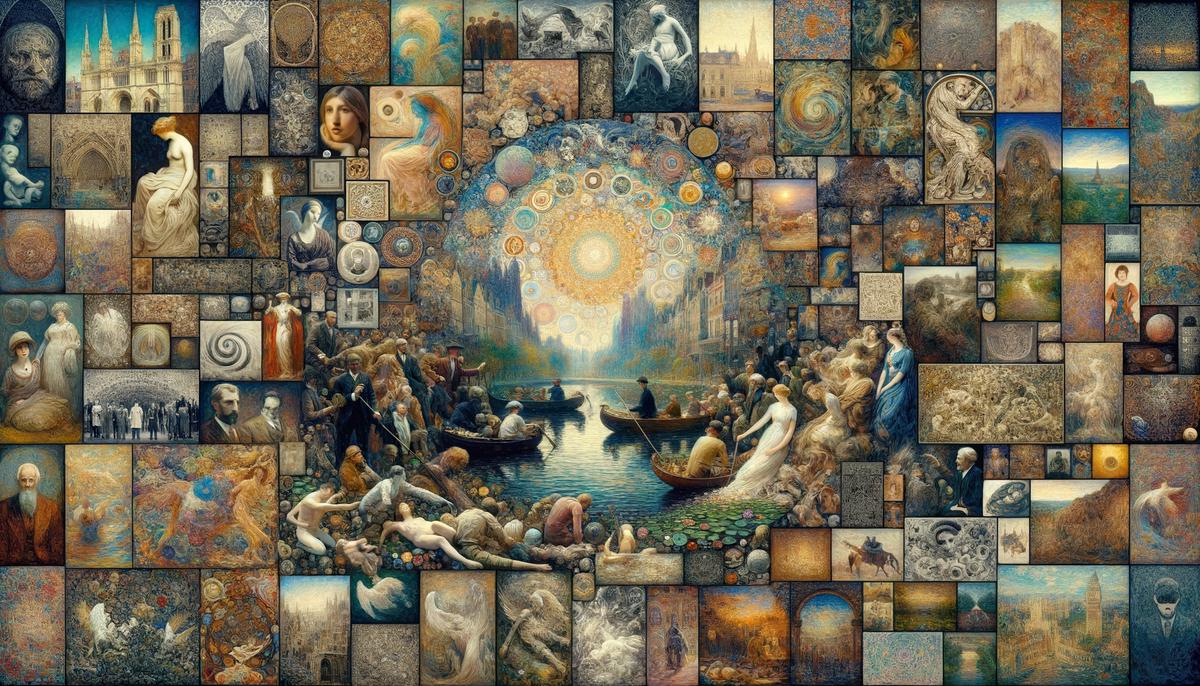Art serves as a conduit for historical and cultural preservation, offering insights into the past while resonating with contemporary themes. What can these artistic treasures tell us about our history, our values, and ourselves?
1. Mona Lisa by Leonardo da Vinci
Leonardo da Vinci's Mona Lisa, housed within the Louvre Museum in Paris, captivates audiences with its enigmatic presence. Created between 1503 and 1505, this masterpiece exemplifies Renaissance ideals of beauty and artistic skill. The subject, commonly believed to be Madame Lisa Gherardini, is depicted with an engaging smile that has puzzled historians and art enthusiasts for centuries. Da Vinci's use of atmospheric perspective innovatively blends the background with the subject, showcasing his mastery over light and texture.
The Mona Lisa also carries a history of mystery and theft. In 1911, it was stolen from the Louvre and missing for two years, an event that heightened its fame. Upon its recovery, the painting's journey back to the museum cemented its status as a global icon.
The value of the Mona Lisa is considered priceless, insured for $3 billion, reflecting not just the artwork itself but the rich stories threaded into its heritage. It embodies the pinnacle of artistic achievement and the perpetual quest for knowledge and appreciation of beauty. Da Vinci's masterful ambiguity invites each viewer to find their own meaning within Mona Lisa's gaze, connecting across time and inviting continuous interpretation and admiration.
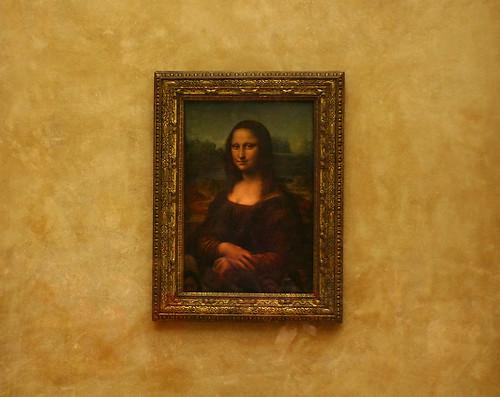
2. The Starry Night by Vincent van Gogh
The Starry Night by Vincent van Gogh, residing in the Museum of Modern Art in New York, is one of the most compelling canvases in the art world. Painted in 1889 from his room in the Saint-Paul-de-Mausole asylum in Saint-Rémy-de-Provence, van Gogh captures the swirling, vivid sky that dominates the village landscape below. The work, executed with dynamic and expressive brushstrokes, embodies the emotional intensity and revolutionary technique characteristic of post-impressionism.
Van Gogh's ability to convey movement, emotion, and the raw beauty of the night sky transforms this painting into a vibrant, living scene. Despite his struggles with mental health, The Starry Night transcends its material form to communicate a deeper sense of connection and introspection, inviting the observer to ponder the broader universe and one's place within it.
The unique approach to light and color in The Starry Night has propelled it to a standing that goes beyond art history; it has become a cultural icon. The swirling sky has infiltrated popular culture, inspiring countless reproductions and permeating discussions around mental health and creative genius. Van Gogh disrupts the notion of night as a time of rest and silence, portraying the evening sky ablaze with activity and vibrance, reminding us that there is a cosmos teeming with movement, even in moments of supposed calm. The Starry Night serves as a testament to the power of art to evoke emotion, provoke thought, and create wonder — an encapsulation of van Gogh's immortal legacy.
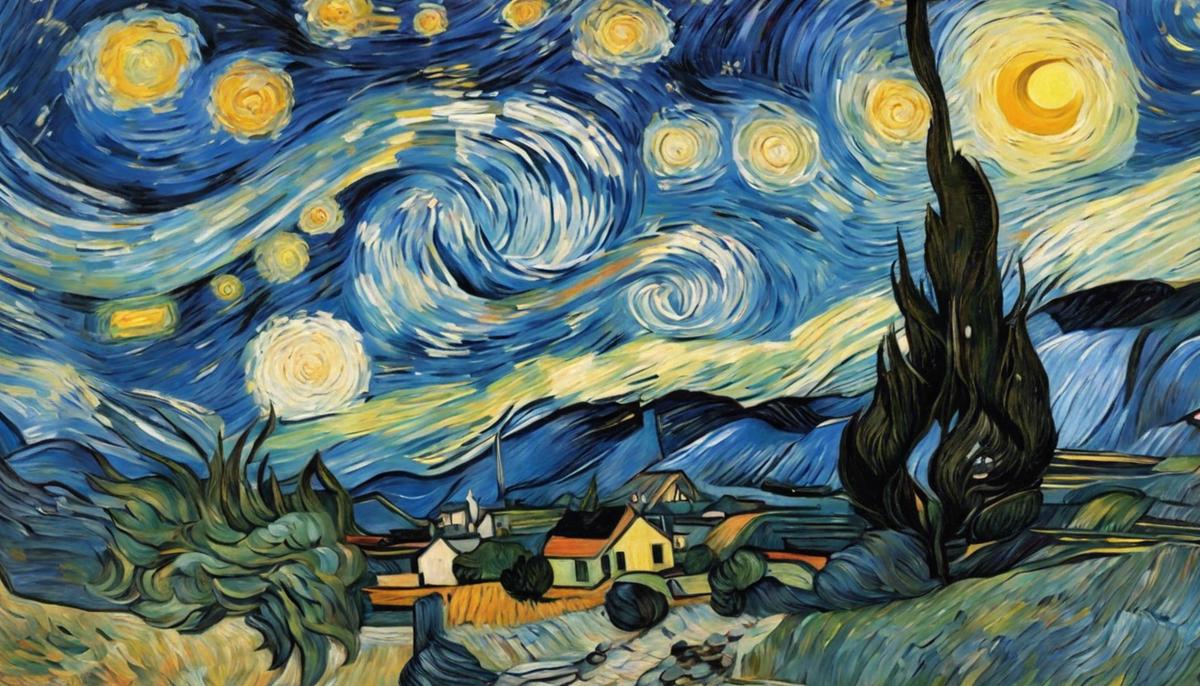
3. The Last Supper by Leonardo da Vinci
Leonardo da Vinci's The Last Supper presents the scene of Jesus' final meal with His disciples before His crucifixion, a moment teeming with emotional intensity and human drama. Created between 1495 and 1498, it represents a significant biblical episode and a landmark in the history of art for its innovative approach to composition and perspective.
Da Vinci's application of one-point perspective centralizes Christ, making Him the focal anchor of the narrative while guiding the observer's gaze across the tableau of apostles, each reacting distinctively to Jesus' announcement of betrayal. Da Vinci's mastery in capturing human emotion shines through, as each apostle displays a mixture of shock, denial, and sadness through varied gestures and expressions.
Underneath the layers of speculation about hidden messages lies da Vinci's intent to depict a moment of profound religious significance and human vulnerability. The careful orchestration of this scene invites viewers to ponder theological themes while empathizing with the apostles' distress.
The Last Supper's influence extends beyond its religious roots; it has infiltrated popular culture, inspiring adaptations and reinterpretations, embedding itself in the collective consciousness as an iconic representation of betrayal and sacrifice. The universal themes of loyalty, faith, and fate interwoven with da Vinci's technical brilliance continue to draw us into this dramatic scene. Through The Last Supper, Leonardo da Vinci bridges the divine with the human, offering a window into the complexities of faith, betrayal, and the profound bond shared among those at the table.
4. Girl with a Pearl Earring by Johannes Vermeer
Johannes Vermeer's Girl with a Pearl Earring, housed within the Mauritshuis Gallery in The Hague, stands as a testament to the power of simplicity and subtlety in art. Painted circa 1665, this piece showcases Vermeer's unparalleled ability to render light and color in a way that infuses a canvas with life. Far more than just a portrait, this work engages the viewer in a silent dialogue that spans centuries.
The subject's direct gaze, coupled with the oversized pearl earring, creates an enigmatic allure that has intrigued art lovers and scholars alike. Vermeer's meticulous attention to the interplay of light and shadow brings a near-photographic realism to the girl's features. Her skin glows softly against the dark backdrop, and the highlight on the pearl earring suggests the skillful manipulation of light.
Yet, for all its technical prowess, the painting's emotional depth stems from its simplicity. The unnamed woman—a commoner, not an aristocrat or mythical figure—becomes a muse representing universal themes of beauty, youth, and serenity. This accessibility gives the work a magnetic pull; viewers see not just a figure from the 17th century but a reflection of timeless human grace.
Girl with a Pearl Earring transcends its era through Vermeer's quiet genius, proving that profound emotional resonance need not shout to be heard. It endures as a beacon of art's power to fascinate and mystify, offering a window into a moment captured in time and a mirror reflecting the varied interpretations and emotions of its beholders.
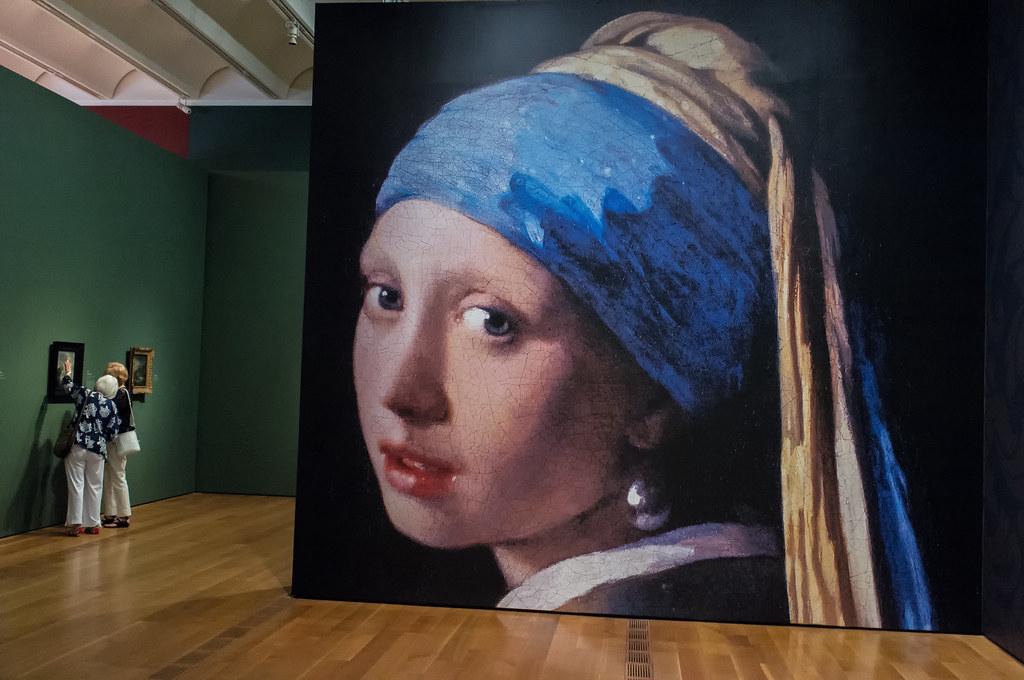
5. Guernica by Pablo Picasso
Pablo Picasso's Guernica, a mural-sized oil painting enshrined in Madrid's Museo Nacional Centro de Arte Reina Sofía, stands as a manifestation of art's capacity to mirror societal turmoil and issue a call for peace. Created in 1937 in response to the aerial bombardment of the Basque town of Guernica during the Spanish Civil War, Guernica harnesses a tumultuous assembly of figures, animals, and shapes interwoven with symbols of pain, death, and despair, articulated through a stark monochromatic palette that accentuates its dramatic impact.
Picasso's decision to render the scene in grayscale imparts a universal newspaper-like quality that transcends specificities of time or nationality, amplifying its anti-war sentiment to a global audience. The painting unfurls a narrative of destruction and suffering:
- A gored horse
- A dismembered soldier
- A wailing mother cradling her child
—a tableau echoing the agonies inflicted by war.
Yet, amid the chaos, Picasso intersperses symbols of hope and resilience—the flower grasped by a broken soldier, the light bulb illuminating the scene, suggesting a perpetual struggle against darkness and violence.
Guernica resonates with urgency decades after its creation because of its unabashed confrontation with the cruelties of war, coupled with an implicit belief in humanity's capacity for compassion and renewal. Picasso deconstructs the narrative of war to underscore the universal suffering it begets and the indomitable spirit that rises in its aftermath.
Guernica transcends its historical roots to stand as a plea for peace and humanity. Its language of pain is universal, traversing barriers of language and culture to communicate a message as relevant today as it was in 1937. As viewers stand before its expansive narrative, they are invited to reflect on the cycles of violence that plague human history and the rays of hope that pierce through even the darkest moments.
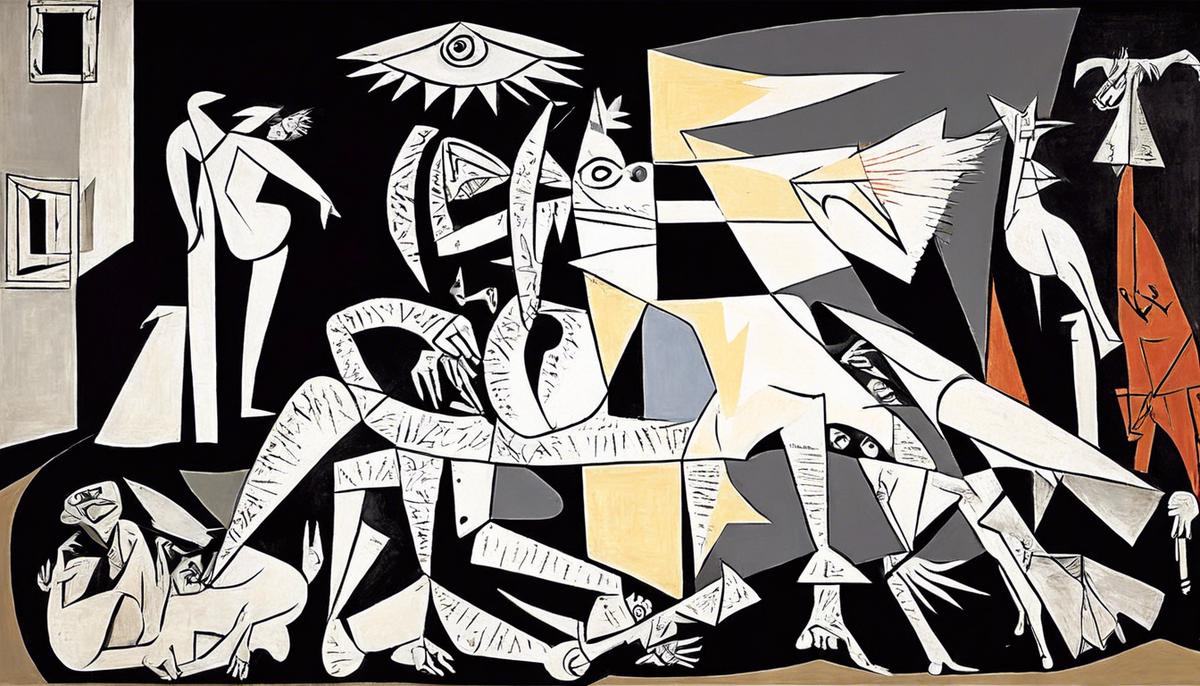
6. The Birth of Venus by Sandro Botticelli
Sandro Botticelli's The Birth of Venus, housed within the Uffizi Gallery in Florence, stands as an emblem of the Renaissance's embrace of Humanist ideals, merging classical mythology with the era's quest for harmonic proportions and aesthetic perfection.
At the heart of Botticelli's masterpiece is Venus, the Roman goddess of love, emerging from the sea shell as an embodiment of ideal beauty and purity. The Birth of Venus daringly presents the nude form as one of divine elegance and grace, signaling a departure from medieval artistic norms and an affirmation of the Renaissance thinkers' adulation of Greco-Roman culture.
The painting's composition is meticulously orchestrated, with Venus standing off-center, drawing the eye across the painting to explore its other symbolic inhabitants:
- Zephyr, the god of winds, propelling Venus to shore
- One of the Horae, goddesses of the seasons, waiting to clothe Venus
This assemblage of figures exemplifies Botticelli's adept use of allegory and symbol to convey deeper philosophical and ethical meanings aligned with Neoplatonic thought.
In the fluid lines and gentle curves that define Venus's features, Botticelli instills a sense of movement that is almost musical. The verdant landscape met by a serene sea further accentuates the painting's dream-like quality, showcasing the painter's sensitivity to detail and his desire to harmonize man with nature, the material with the spiritual.
The Birth of Venus poses questions about the nature of divine beauty, humanity's place in the universe, and art's ability to encapsulate both temporal and eternal truths. By presenting Venus as a beacon of intellectual and spiritual purity, Botticelli invites viewers to ponder the deeper connections linking beauty, morality, and knowledge.
Botticelli's masterpiece remains not just a narrative of mythological origins but a conduit for enduring human inquiries about existence, beauty, and the divine realm's resonance in our worldly experiences. It celebrates humanist ideals, the transformative power of art, and reflects on the nature of rebirth and creativity.
7. Night Watch by Rembrandt van Rijn
Rembrandt van Rijn's Night Watch, housed within Amsterdam's Rijksmuseum, stands as a towering achievement in art history. Executed in 1642, this monumental work breaks away from the static conventions of militia portraiture, infusing it with unprecedented life, movement, and depth. Rembrandt harnesses the dramatic potential of chiaroscuro—the compelling interplay of light and shadow—to animate the scene with vitality and immediacy.
What sets Night Watch apart is not merely its grand scale but the innovative manner in which Rembrandt orchestrates the composition. The scene is a snapshot of controlled chaos, a flurry of action captured with remarkable precision. At the heart of this kinetic whirlwind is Captain Frans Banning Cocq, dressed in black, commanding his lieutenant to lead their company forward. The figures around them, each illuminated to varying degrees by an unseen light source, participate in a choreographed dance of preparation and anticipation.
Rembrandt's technique highlights the central figures and imbues the entire tableau with a three-dimensional quality, drawing the viewer into the picture's narrative heart. His understanding of human emotion and ability to render textile textures and reflective surfaces contribute to the scene's overwhelming sensory impact.
The painting's original title was lost to time, being nicknamed "The Night Watch" only in the 18th century due to the darkening varnish that led many to mistakenly interpret the scene as taking place at night. Later restoration efforts revealed its true setting: a daylit departure from traditional portraiture into a vivid, lively tableau that encapsulates the pride and solidarity of Amsterdam's civic guards.
Night Watch showcases Rembrandt's virtuosic skill as a painter and serves as a commentary on the social and political undercurrents of his time. The militia, depicted as dynamic individuals, personifies the Dutch Golden Age's spirit—a period marked by prosperity, artistic innovation, and a burgeoning sense of national identity.
As viewers stand before Night Watch, they are invited to ponder the complexities of leadership, camaraderie, and the civic duty that binds individuals to larger societal constructs. Rembrandt's portrayal of these men poised on the precipice of action reminds us of the enduring human quest for light in the shadowy corridors of existence and the intrinsic beauty found in our collective endeavors to protect and serve our communities.
Through Night Watch, Rembrandt van Rijn cements his legacy as a master painter and storyteller, whose narratives continue to resonate with depth, dignity, and a timeless understanding of human nature. This masterpiece remains a testament to art's power to capture the vibrancy of life, immortalizing a moment of anticipation and unity in the face of an ever-unfolding story.
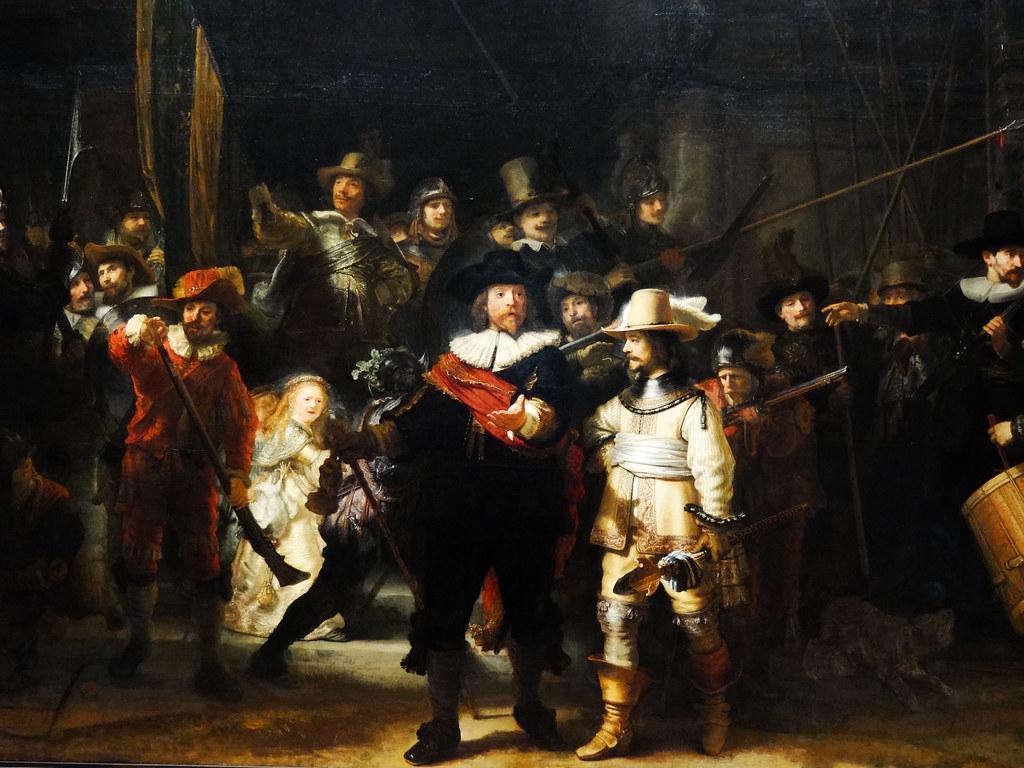
8. The Garden of Earthly Delights by Hieronymus Bosch
Hieronymus Bosch's The Garden of Earthly Delights, residing within the Prado Museum in Madrid, astonishes and mystifies with its lush, detailed depiction of earthly pleasure, divine duality, and eventual damnation.
Bosch encapsulates, in a series of vibrant panels, a visual meditation on the ebbs and flows of human morality and the inherent seduction of carnal delights:
- The left panel gently ushers us into the narrative with the depiction of Eden, portraying God introducing Eve to Adam, setting the stage for the unraveling human saga.
- The center panel teems with naked figures engaging in whimsical joy, ensnared in pleasures that suggest the transient nature of human contentment. This panel, swarming with an array of surreal, hybrid beings mingling with humans amidst fantastical structures, prompts one to ponder – what temptations entice us today? Bosch's portrayal transcends the temporal, his chaotic representation of delight ensuring an undying allure and relevance.
- The right panel confronts the viewer with the consequences of moral degradation – a dark, foreboding hellscape where the intricacies of punishment underscore the fragility of righteousness. Here, Bosch's prodigious talent conjures a world where the chaos of the central panel culminates into ultimate dread and suffering. Fiery landscapes, monstrous beasts, and despairing figures compel viewers to confront the stark extremities of divine reckoning.
Each detail meticulously woven into this hellscape proffers a silent query about the choices rendering us susceptible to metaphorical damnation.
Bosch imbues each panel with complex symbolism; his work, a riddle wrapped in medieval symbolism, perches on the precipice between didactic cautionary tale and an exploration of human nature's multifaceted canvas. Inducing discussions and scholarly debates about real intent versus interpreted meanings for centuries, The Garden of Earthly Delights remains an enigmatic masterpiece, cloaked in mystery. Its true message — whether a hopeful reminder of divine salvation, a sharp critique of moral decay, or a layered representation of celestial judgment — invites varied interpretations.
Bosch's ability to fuse divine, diabolic, and earthly narratives into a singular vision stirs the mind and spirit alike. The enduring fascination with The Garden of Earthly Delights speaks to his unparalleled capacity to enchant, questioning our values, fears, and grandest aspirations. This triptych acts as a mirror reflecting our collective psyche's complexities, engaging us in a timeless dialogue about virtues, vices, and the inescapable human condition.
As beholders stand before Bosch's multidimensional canvas, lost in its myriad details and implications, we are reminded of art's profound influence on introspection and moral contemplation. Through The Garden of Earthly Delights, Hieronymus Bosch challenges us to traverse beyond surface beauty, plunging into the depths of meaning, morality, and the eternal quest for understanding espoused within this labyrinthine creation. It crystallizes as an existential exploration of life's perpetual enigmas.
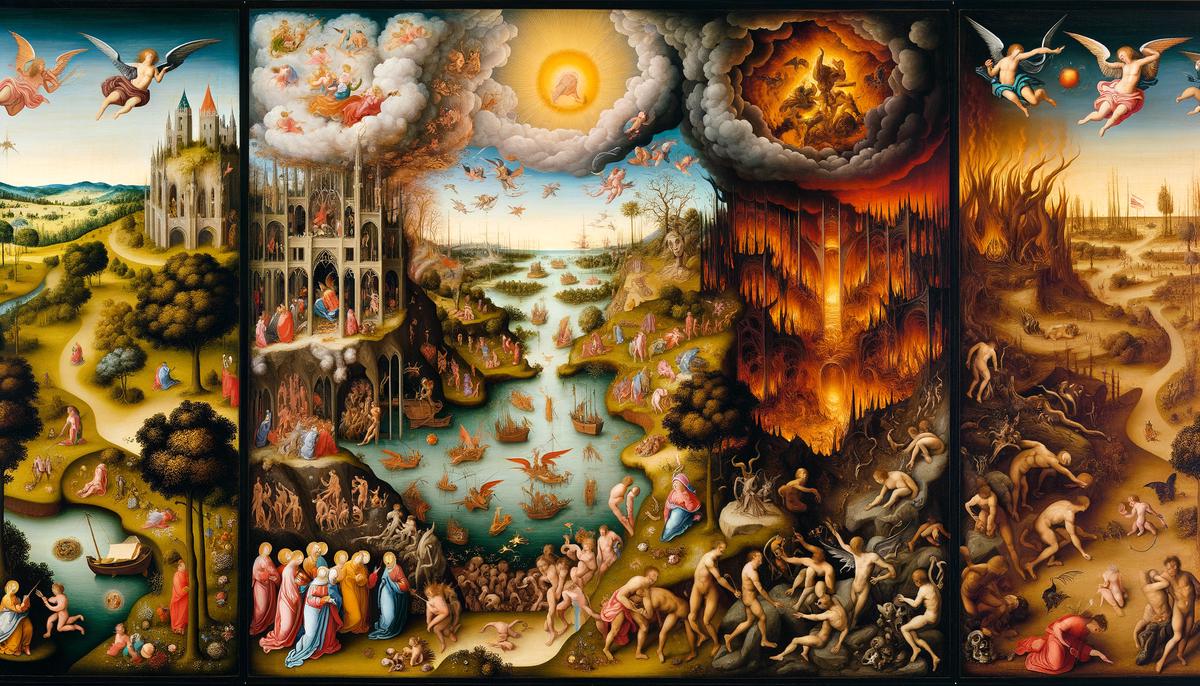
9. Liberty Leading the People by Eugène Delacroix
Eugène Delacroix's Liberty Leading the People vividly captures the essence and fervor of revolutionary spirit, encapsulating the July Revolution of 1830 with a blend of realism and allegory. This powerful painting, housed in the Louvre, Paris, marks a pivotal moment in French history and symbolizes the universal quest for freedom and justice.
At the canvas's heart stands Marianne, an allegorical representation of Liberty, who leads a disparate group of revolutionaries forward over the barricades and the bodies of the fallen. Clad in the colors of the French flag, she embodies both the nation's ideals and the universal yearning for liberty. Her raised arm brandishes the Tricolor flag, an enduring symbol of unity and rebellion, guiding the people toward triumph amidst chaos.
Delacroix masterfully weaves a tapestry of human emotion and determined resolve, portraying a cross-section of society united in purpose. From the determined gaze of the workers to the youthful fervor of the students, each figure contributes to a narrative rich in complexity and diversity. The inclusion of a wide range of participants underscores the revolution's collective nature, highlighting that the struggle for freedom transcends class and age.
Delacroix juxtaposes the angst of battle with the exaltation of idealistic aspiration to underscore the inherent duality of revolution – the unavoidable toll in human life and suffering set against the backdrop of a higher cause, a testament to humanity's resilience in the face of oppression. The rendering of Marianne as both tender and formidable, guiding the people with unwavering conviction, amplifies this painting's emotive power, inviting viewers to reflect on the sacrifices made in freedom's name.
Liberty Leading the People extends beyond its historical context to resonate with a timeless appeal, echoing the universal and perpetual struggle against tyranny. Delacroix's work remains emblematic of the indomitable will of people worldwide to claim their rights and shape their destinies. The painting serves as a historical record and a beacon of hope, demonstrating art's profound capacity to inspire, commemorate, and motivate.
Delacroix's magnum opus provokes contemplation about the essence of liberty and the price of its acquisition. It reminds us that liberty is both a precious gift and a responsibility — an inheritance won through courage, unity, and perseverance. Delacroix does not merely document an event; he elevates it into a timeless call to valor and vigilance in the quest for liberty.
As Liberty Leading the People courses through the annals of art history, it challenges us to ponder our roles in the ongoing narrative of freedom and justice. It implores us to remember that the quest for liberty is enduring, rooted deeply in the human spirit's core. Through Delacroix's lens, we are beckoned to witness the valor of those who paved the way for freedoms we cherish and to embrace our part in safeguarding them for future generations.
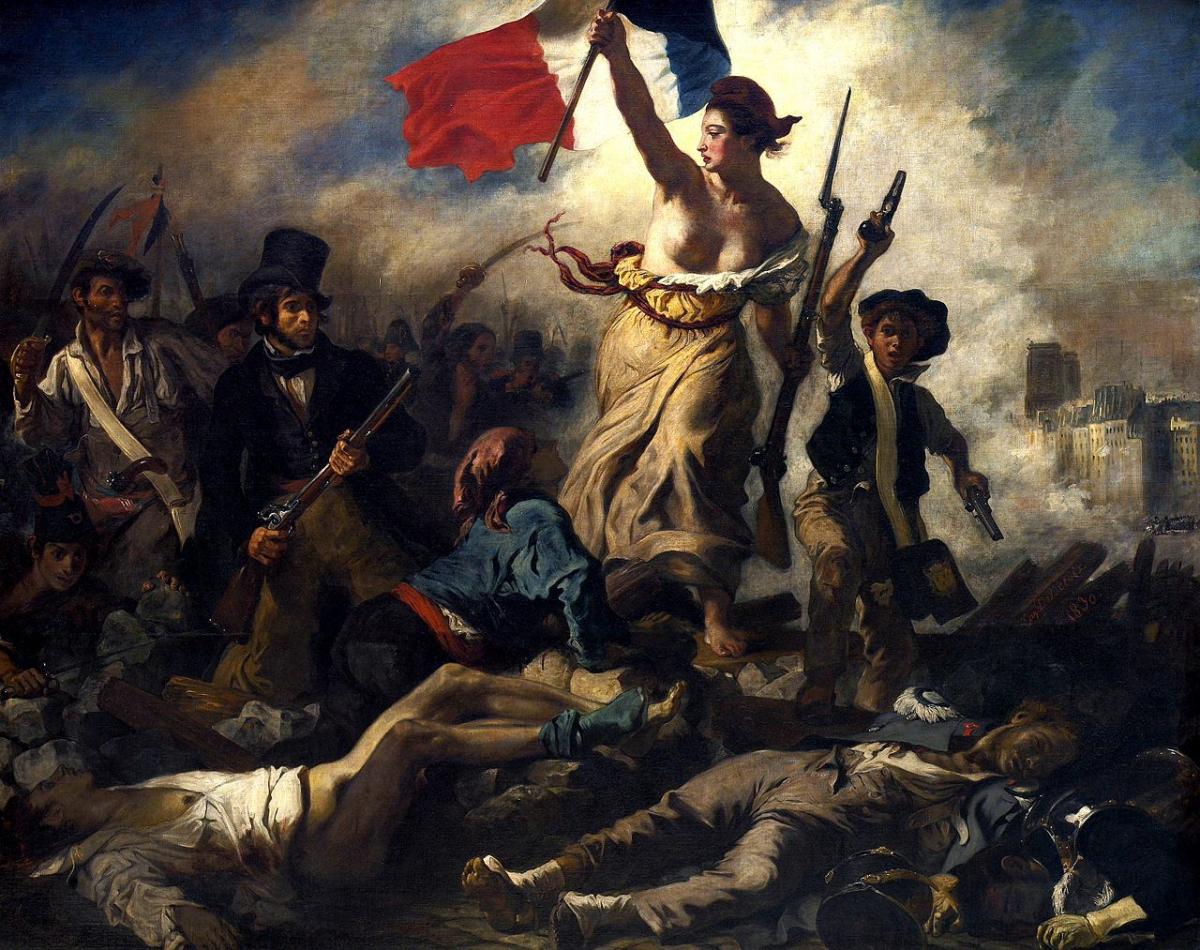
10. The Scream by Edvard Munch
Edvard Munch's The Scream is a profound embodiment of psychological turmoil and existential dread, capturing the essence of anguish. This expressionist masterpiece features an androgynous figure set against a tumultuous, blood-red sky—their mouth agape in a silent scream.
Housed in the National Gallery in Oslo, Munch created four versions of this compelling piece between 1893 and 1910, using paints, pastels, and prints. The backdrop, inspired by a sunset Munch witnessed in Oslo, serves as a dramatic landscape and a psychic battlefield where nature echoes the figure's inner turmoil.
Munch's own diaries hint at a moment of existential crisis, where the setting sun's overwhelming blood-red hue incited a sense of dread. This portrayal articulates a universal panic—the uncertainty of existence and our own insignificance in the vast tapestry of life.
The composition—a bridge leading nowhere, the friends fading in the distance—amplifies the feeling of isolation and alienation. The figure, trapped between the serene waters below and the swirling fiery sky, encapsulates humanity's plight, caught between the rational world and the unfathomable depths of our own minds.
The Scream is a symbol that has seeped into the cultural consciousness, embodying the anxiety of the modern age. Its haunting image taps into our collective fears and uncertainties, reflecting the angst of a world on the brink of change and the individual's confrontation with their own existential terror.
The painting's resonance lies in its unflinching look into the abyss—the confrontation with the internal, inarticulate howl of despair that lurks within us all. Munch invites us to acknowledge and confront our fears. In recognizing our vulnerabilities, we find a shared empathy, an understanding that we are not alone.
Through The Scream, Edvard Munch communicates a fundamental human truth—the experience of angst is universal, transcending personal sufferings to touch upon something elemental in the human spirit. It provokes dialogue about the nature of our fears, the sources of our anxieties, and the means by which art can offer catharsis or even healing.
As we stand before The Scream, we are compelled to confront our fragilities, fears, and the moments that push us to the edge. In this confrontation lies a form of liberation—a release from pretensions towards a genuine engagement with our existence. Munch's masterpiece remains a powerful testament to art's ability to evoke complex emotional landscapes, encouraging an introspective journey through the silent screams echoing within.
Art transcends mere aesthetic appeal to act as a beacon of cultural memory and historical insight. It invites us to reflect on our collective journey through time, encouraging a deeper understanding of the threads that weave together our shared human experience.
This pivotal role of art in preserving our cultural heritage underscores its enduring value and relevance in society. Through the brush strokes of the masters, the chiseled forms of sculptors, and the visionary lenses of photographers, we gain a window into the past—a glimpse of the hopes, fears, triumphs, and struggles that have shaped our world.
Art serves as a testament to the human spirit, capturing the essence of an era and the zeitgeist of a generation. It encapsulates the values, beliefs, and aspirations of a society, providing future generations with a tangible link to their roots.
Moreover, art has the power to transcend cultural boundaries, fostering understanding and empathy among diverse peoples. It speaks a universal language, conveying emotions and experiences that resonate across time and space. Through art, we recognize our shared humanity and the common threads that bind us together.
As custodians of our cultural legacy, we have a responsibility to preserve and celebrate the artistic achievements of our predecessors. By safeguarding these treasures, we ensure that future generations can draw inspiration, knowledge, and wisdom from the rich tapestry of human creativity.
In a world that is constantly evolving, art remains a steadfast anchor, reminding us of who we are, where we have been, and the limitless possibilities of the human imagination. It is a testament to our resilience, our ingenuity, and our indomitable spirit.
So let us cherish the art that surrounds us, recognizing its power to illuminate the past, enrich the present, and shape the future. For in the enduring beauty of art, we find a mirror of ourselves and a reflection of the world we aspire to create.
